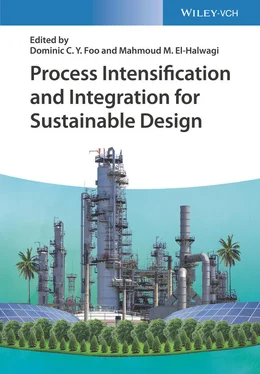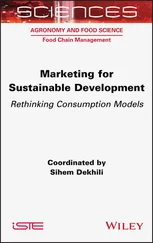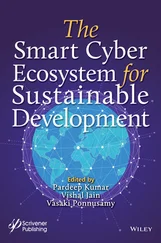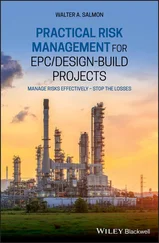Section 2 – Process Integration
The second section of the book features eight chapters on process integration. Chapters 7– 9present some latest advancements in heat exchanger network (HEN) synthesis. While Chapters 7and 8are based on pinch analysis techniques, Chapter 9is based on mathematical programming technique. Chapter 7entitled “Graphical Analysis and Integration of Heat Exchanger Networks with Heat Pumps” (by Yang and Feng ), presents pinch analysis‐based strategies for the integration with heat pumps as well as heat pump‐assisted distillation with HEN. In Chapter 8that is entitled “Insightful Analysis and Integration of Reactor and Heat Exchanger Network” (by Zhang and coworkers ), a combined multi‐parameter optimization diagram (CMOD) is proposed to allow better integration of reactors with the HEN, taking into consideration of energy consumption, temperature, selectivity, and reactor conversion. Next, a new methodology named as velocity optimization is proposed in Chapter 9, entitled “Fouling Mitigation in Heat Exchanger Network Through Process Optimization” (by Wang and Feng ). This new methodology allows the correlation of fouling, pressure drop, and heat transfer coefficient of heat exchangers with velocity; this allows velocity distribution to be determined among all the heat exchangers in the HEN. Chapter 10entitled “Decomposition and Implementation of Large‐Scale Interplant Heat Integration” (by Song and coworkers ) proposed a three‐step strategy for the decomposition of large‐scale inter‐plant heat integration problem. The chapter also proposes a new pinch analysis technique to identify the maximum interplant heat recovery potential, while minimizing the corresponding flow rates of heat transfer fluids. Chapter 11entitled “Multi‐objective optimisation of integrated heat, mass and regeneration networks with renewables considering economics and environmental impact” (by Isafiade and coworkers ) presents a mathematical programming method for multi‐period combined heat and mass exchange network s (CHAMENs) in which a regeneration network is included; the latter consists of multiple recyclable mass separating agents and regenerating streams. In Chapter 12entitled “Optimization of Integrated Water and Multi‐regenerator Membrane Systems Involving Multi‐contaminants: A Water‐Energy Nexus Aspect” (by Abass and Majozi ), another mathematical approach was presented for the synthesis of integrated water and membrane network; the latter consists of detailed models of electrodialysis and reverse osmosis units that are embedded within a water regeneration network. Chapter 13entitled “Optimization Strategies for Integrating and Intensifying Housing Complexes” (by Núñez‐López and Ponce‐Ortega ) provides an overview of process integration and intensification for housing complexes, the latter is typically a much larger scale as compared to industrial processes. In the last chapter entitled “Sustainable Biomass Conversion Process Assessment Contributing to ‘Process Intensification and Integration for Sustainable Design’” (by Tan ), a multi‐objective process sustainability evaluation methodology known as GREENSCOPE ( Gauging Reaction Effectiveness for ENvironmental Sustainability of Chemistries with a multi‐Objective Process Evaluator ) is demonstrated to track process sustainability performance for a biomass conversion process.
These 14 chapters cover some of the most recent and important developments in process intensification and process integration. We hope the book will serve as a useful guide for researchers and industrial practitioners who seek to develop tools and applications for process improvement and sustainable development.
Dominic C. Y. Foo
Mahmoud M. El‐Halwagi
Kajang, Malaysia
College Station, United States
January 2020
1 Shale Gas as an Option for the Production of Chemicals and Challenges for Process Intensification
Andrea P. Ortiz‐Espinozaand Arturo Jiménez‐Gutiérrez
Tecnológico Nacional de México, Instituto Tecnológico de Celaya, Chemical Engineering Department, Ave Tecnologico y Garcia Cubas, Celaya, 38010, Mexico
Shale gas is unconventional natural gas trapped or adsorbed in shale rock formations. As opposed to conventional natural gas, shale gas is difficult to extract because of the low porosity of the rock formations in which it is confined. This particular characteristic implied a high cost for the extraction of this gas, so that its production remained unfeasible until the development of more suitable extraction technologies, such as hydraulic fracturing and horizontal drilling [1]. Hydraulic fracturing is a stimulation technique used to increase the flow rate of gas and oil in low permeability reservoirs. This method consists in injecting high‐pressurized fluids into the well to create fractures and maintain them opened to allow the flux of gas and oil [1,2]. Hydraulic fracturing is generally combined with horizontal drilling to increase the area covered with a lower number of wells. These two technologies have led to an increase in the net production of natural gas in the United States (US) for more than a decade, which has been referred to as the shale gas revolution [1,3].
The aim of this chapter is to give an overview of shale gas and its potential to produce value‐added chemicals. This chapter addresses the following aspects: shale gas composition and places where deposits are located, effect of shale gas discoveries on natural gas prices, alternatives to produce chemicals from shale gas, and opportunities for process intensification.
Although shale gas has been known for a while, the first shale gas well was drilled in 1821 in Chautauqua, NY, its exploitation was possible only until the development of hydraulic fracturing and horizontal drilling technologies. After the oil crises of the 1970s, the US government and some oil and gas companies, separately, initiated the investment in research projects to evaluate and make shale gas extraction possible. From the beginning of the 2000s, technical and economic factors promoted the idea to produce natural gas from shale formations. The Barnett shale play was the first basin to be exploited in a large scale, with the hydraulic fracturing technology being tested there. Following the success to extract natural gas from the Barnett shale play, shale gas extraction began in other locations. Table 1.1gives basic information about the major shale gas plays in the United States.
Table 1.1Major shale gas plays in the United States.
Source: Adapted from EIA 2018 [4].
| Shale play |
State(s) |
Percentage of dry shale gas production in 2018 |
| Marcellus |
PA, WV, OH, and NY |
32.7 |
| Permian |
TX and NM |
12.3 |
| Utica |
OH, PA, and WV |
11.3 |
| Haynesville |
LA and TX |
11.0 |
| Eagle Ford |
TX |
7.1 |
| Woodford |
OK |
5.0 |
| Barnett |
TX |
4.4 |
| Mississippian |
OK |
3.8 |
| Niobrara–Codell |
CO and WY |
3.4 |
| Bakken |
ND and MT |
2.7 |
| Fayetteville |
AR |
2.3 |
| Rest of the United States “shale” |
|
4.0 |
Apart from US reserves, recoverable shale gas resources around the world have been found in countries such as China, Argentina, Algeria, Canada, Mexico, Australia, South Africa, and Russia [3,5]. Despite these discoveries, several factors such as geological aspects and the lack of the necessary infrastructure have curbed the development of the shale gas industry in those other countries [6,7]. Table 1.2shows the production rates in 2018 for the six countries with more unproved technically recoverable shale gas resources.
Читать дальше












